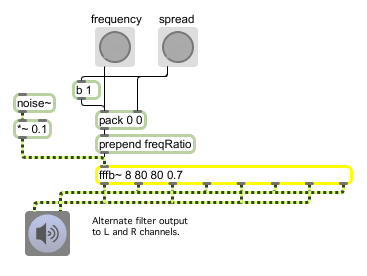Examples

Stereo expansion by altering the base frequency and frequency ratio
Fast fixed filter bank
| Name | Type | Opt | Description |
|---|---|---|---|
| number-of-filters | int | Obligatory. The first argument specifies the number of filters. | |
| 1st-filter-frequency (float) remaining-filter-frequency-ratios (float) and general-Q-factor (float) | list | opt | Three additional float arguments may be used to specify the frequency of the first filter, the ratio of frequencies between successive filters, and the Q factor for all of the filters. |
| harmonic-series-flag (H) | symbol | opt | If you use the letter H as the second argument rather than a float, the filters will be tuned to a harmonic series rather than with ratios of frequencies. |
| list | filter-index and settings [list] |
Performs the same function as . |
| anything | filter-index and settings [list] |
A filter index followed by just a frequency or a frequency and a Q setting will set the particular filter addressed by the index number to the settings which follow it. |
| Q | bandwidths [list] |
In left inlet: The symbol , followed by a list consisting of an int and one or more floats, sets the Q factors of the filters, starting with the filter whose index is given by the first number. This filter's Q factor is set to the second number in the list. Any following numbers in the list set the Q factors of filters following the first designated one. Indices are zero-based. |
| QAll | general-bandwidth [list] |
In left inlet: The word , followed by a float, sets the Q of all of the filters to the given floating-point value. |
| clear | Clears the fffb~ object's memory of previous inputs and outputs. | |
| freq | filter-frequencies [list] |
In left inlet: The word , followed by a list consisting of an int and one or more floats, sets the center frequencies of the filters starting with the filter whose index is given by the first number. This filter's frequency is set to the second number in the list. Any following numbers in the list set the frequencies of filters following the first designated one. Indices are zero-based. For example, the message sets the frequency of the fourth filter to 1974Hz, the fifth filter to 333Hz, and the sixth filter to 1234Hz. |
| gain | amplitudes [list] |
In left inlet: The word , followed by a list consisting of an int and one or more floats, sets the gains of the filters starting with the filter whose index is given by the first number. This filter's gain is set to the second number in the list. Any following numbers in the list set the gains of filters following the first designated one. Indices are zero-based. |
| freqAll | general-center-frequency [list] |
in left inlet: The word , followed by a float, sets the center frequencies of all of the filters to the given floating-point value. |
| freqRatio | frequency-ratios [list] |
In left inlet: The word , followed by a list of two or more numbers sets the center frequency of the first filter to the first value in the list, and sets the frequencies of the remaining filters by repeatedly multiplying the first value by the second, so that the ratio of frequencies of successive filters is the second value. For example, the message sets the frequency of the first filter to 440Hz, the frequency of the second to 880Hz, the frequency of the third to 1760Hz, and so on. If the second item in the list is the letter rather than a number, the filters will be tuned in a harmonic series. For example, the message sets the frequencies of the filters to 100Hz, 200Hz, 300Hz, 400Hz, and so on. |
| gainAll | general-amplitude [list] |
In left inlet: The word , followed by a float, sets the gain of all of the filters to the given floating-point value. |
| signal | The signal present at the left inlet is sent to all of the filters. |

| Name | Description |
|---|---|
| reson~ | Resonant bandpass filter |